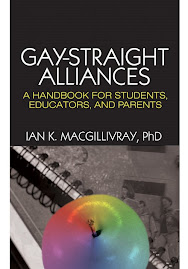Context/Premise:
Homosexuality, gays, gayness, lesbians, straight, invisible, speaking out, community, education, right vs. wrong, sin, stereotypes, the norm, conformity, recognition, silence, representations, sexual identity, challenge, power, abnormal, marginalization, identity, homogenous, purity, isolation, teachers, students, public schools, confidence, conflict and respect.
Argument:
Dennis Carlson argues that keeping “gayness in its place” within the public school community is something which is becoming increasingly “harder to sustain”.
Evidence:
“Gay people for the most part have been made absent, invisible, and silent within this community.”
“Public schools in particular have often promoted such “normalizing” conceptualization of community that are based on defining a cultural center or “norm” and positioning class, gender, race, and sexual others at the margins.”
“Since all normalizing communities maintain a center and margin in the face of opposition and resistance from those being marginalized, analysis needs to proceed through an account of the specific techniques and apparatuses of power that have been employed in the school to keep gayness “in its place” as an invisible presence.”
“Erasure of gayness in the curriculum, the closeting and witch hunting of gay teachers, and verbal and physical intimidation of gay teachers and students.”
These are the three techniques which Carlson uses to describe the process of normalizing or in other words keeping “gayness in its place”. Unfortunately these things are very true and gayness is not present enough in the school curriculum. Carlson talks of how “major textbook publishers avoid gayness like the plague.” He also talks of how gayness is evident within health textbooks only when being associated with the disease, the evidence which supports this is found below.
“One of the most popular health texts on the high school market is Health: A Guide to Wellness, which mentions homosexuals or homosexuality once in acknowledging that “the first group in the United States diagnosed with AIDS were male homosexuals.”
“One of the primary means of ensuring that gayness was an invisible presence in the school was through the dismissal of teachers who were found out to be homosexual.”
After reading this document I just do not understand why people cannot be excepting of other people who may have a difference in opinion or sexuality. If it does not affect you then why do you care? I also found myself gasping when I read about the student who outright humiliated the male substitute teacher while also making a fool of herself. I understand that everyone has a right to their opinion, but, to be cruel is something else. After reading this document it is clear that gayness is an issue with many conflicts, especially when in the context of public schools.

About Me
- kendra
- heyy...my names kendra. I'm a sophmore @ ric studying to become an Eled. teacher with a concentration in social studies. I run xc and track for RIC and played soccer my freshmen year. I've been with my boyfriend for 5 years & goin strong haha<3 FYI me and katie are cousins :)so there's a little about me...ttyl
Monday, February 25, 2008
Monday, February 18, 2008
"Teaching Multilingual Children" by Virginia Collier
Context/Premise:
“Teaching Multilingual Children” by Virginia Collier expressed many themes, including:
Teaching styles, teachers, students, students learning abilities, English, cultural values, ESL, bilingual, respect, home language vs. school language, learning, how students learn, techniques, factors (social and emotional), academic language vs. casual language, communication, stigmas, appreciation, recognition, code-switching, borrowing, literacy, successfulness, speech, children, methods and using available resources.
Argument:
Virginia Collier argues that teachers must recognize and obtain a “true appreciation of the different linguistic and cultural values that students bring into the classroom” and “be critically aware of the social and emotional factors which affect the second language learner”; as well as, how to accurately teach the child/student that both home and academic languages are important and should not be disregarded.
Evidence:
Evidence which suggests what Virginia Collier argues:
1. “Teachers must serve as a catalyst for discovery as students learn to operate effectively in their multiple worlds.” {pg. 223}
Teacher’s jobs are to help direct their students without discouraging their own creativity and sense of self. In order for children who have learned English as their second language to become successful citizens they must understand the codes of power as Lisa Delpit would argue. However, the question of “how to teach (standard) English in a way that respects and affirms the multiple home languages and dialects represented among students in class” is still being asked, which Collier answers in the above quote. She believes it is up to the teachers to “serve as a support base” and encourage the students individuality and or identity.
2. “The critical distinction to maintain is between how children acquire the capacity to converse casually in a second language and how they learn to become proficient students using second language.” {pg. 225}
The ability of the student or child to communicate affectively in the outside world is much different than the development of speaking in the appropriate academic language style. Collier examples that “teachers are responsible for facilitating academic language development” in their students. Academic language does not come as easily or quickly to children as “context reduced communication” does. Context reduced communication is another way of saying casual or outside world talk, which tends to rely on linguistic cues such as gestures and intonation from the other speaker, rather than abstract thinking.
3. “People untrained in linguistics tend to believe that if limited English proficient students can converse with their monolingual English-speaking peers, then these English-language learners can compete with them on equal footing.” {pg. 225}
This idea that just because the students can converse easily with other students who speak English as a first language means that they can compete with them equally in society or school is not an educated assumption. It is much easier to speak with peers than it is to speak accurately in the academic world. The skills needed to compete can sometimes be lost in transition from native language to academic language.
4. “Don’t teach a second language in any way that challenges or seeks to eliminate the first language.” {pg. 227}
This is a question which I have been asking myself. How exactly am I supposed to teach the culture of power without offending a student’s culture or heritage? Virginia Collier would argue that a teacher’s most important goal is to “help their students master the language used in formal schooling (academic language proficiency) and at the same time give their students language tools for use in all contexts in the outside world.” But, exactly how should this be done? Throughout the text Collier gives different methods which can used to teach students the ways in which to effectively learn English, however, it seems to me that it has more to do with experience. Through experience and reading these sorts of text a teacher will learn how to effectively get through to their student so that they are not ashamed of where they come from and how to be successful in the world which is dominated by the culture of power.
5. “Do not forbid young students from code switching in the classroom. Understand the functions that code switching serves.” {229}
When is it incorrect to code switch? How is the teacher to know whether the student understands what they are trying to say if they are code switching to something which is familiar in order to get their point across? Collier states that “code switching also should not be confused with borrowing.” How is a teacher to know whether they are code switching or borrowing? Does code switching also mean that they do not know how to say whatever it is they are trying to say in English so they revert to what is comfortable? I recognize that it is not a linguistic weakness and that “accepting code switching might produce better academic results than a constant preoccupation with maintaining a single language.”
6. “The most successful long-term academic achievement occurs where the students’ primary language is the initial language of literacy.” {233}
Collier provides evidence in which students learn English literacy better when they are first taught it in their native and or original language. She says that “using the home language for literacy builds the self-worth of language minority students.” The first language transfer to the second is actually quite swift and easier than may be assumed. For this reason the student should learn literacy in their native language so that they can easily transfer what they already know into the second language.
- Ultimate goal ~ “It is hoped that the learning process will not only enrich the life of the student, but also that of his or her teacher.” {pg. 235}
Both student and teacher have the ability to learn from one another and that is something which should be greatly encouraged in the world of academics.
“Teaching Multilingual Children” by Virginia Collier expressed many themes, including:
Teaching styles, teachers, students, students learning abilities, English, cultural values, ESL, bilingual, respect, home language vs. school language, learning, how students learn, techniques, factors (social and emotional), academic language vs. casual language, communication, stigmas, appreciation, recognition, code-switching, borrowing, literacy, successfulness, speech, children, methods and using available resources.
Argument:
Virginia Collier argues that teachers must recognize and obtain a “true appreciation of the different linguistic and cultural values that students bring into the classroom” and “be critically aware of the social and emotional factors which affect the second language learner”; as well as, how to accurately teach the child/student that both home and academic languages are important and should not be disregarded.
Evidence:
Evidence which suggests what Virginia Collier argues:
1. “Teachers must serve as a catalyst for discovery as students learn to operate effectively in their multiple worlds.” {pg. 223}
Teacher’s jobs are to help direct their students without discouraging their own creativity and sense of self. In order for children who have learned English as their second language to become successful citizens they must understand the codes of power as Lisa Delpit would argue. However, the question of “how to teach (standard) English in a way that respects and affirms the multiple home languages and dialects represented among students in class” is still being asked, which Collier answers in the above quote. She believes it is up to the teachers to “serve as a support base” and encourage the students individuality and or identity.
2. “The critical distinction to maintain is between how children acquire the capacity to converse casually in a second language and how they learn to become proficient students using second language.” {pg. 225}
The ability of the student or child to communicate affectively in the outside world is much different than the development of speaking in the appropriate academic language style. Collier examples that “teachers are responsible for facilitating academic language development” in their students. Academic language does not come as easily or quickly to children as “context reduced communication” does. Context reduced communication is another way of saying casual or outside world talk, which tends to rely on linguistic cues such as gestures and intonation from the other speaker, rather than abstract thinking.
3. “People untrained in linguistics tend to believe that if limited English proficient students can converse with their monolingual English-speaking peers, then these English-language learners can compete with them on equal footing.” {pg. 225}
This idea that just because the students can converse easily with other students who speak English as a first language means that they can compete with them equally in society or school is not an educated assumption. It is much easier to speak with peers than it is to speak accurately in the academic world. The skills needed to compete can sometimes be lost in transition from native language to academic language.
4. “Don’t teach a second language in any way that challenges or seeks to eliminate the first language.” {pg. 227}
This is a question which I have been asking myself. How exactly am I supposed to teach the culture of power without offending a student’s culture or heritage? Virginia Collier would argue that a teacher’s most important goal is to “help their students master the language used in formal schooling (academic language proficiency) and at the same time give their students language tools for use in all contexts in the outside world.” But, exactly how should this be done? Throughout the text Collier gives different methods which can used to teach students the ways in which to effectively learn English, however, it seems to me that it has more to do with experience. Through experience and reading these sorts of text a teacher will learn how to effectively get through to their student so that they are not ashamed of where they come from and how to be successful in the world which is dominated by the culture of power.
5. “Do not forbid young students from code switching in the classroom. Understand the functions that code switching serves.” {229}
When is it incorrect to code switch? How is the teacher to know whether the student understands what they are trying to say if they are code switching to something which is familiar in order to get their point across? Collier states that “code switching also should not be confused with borrowing.” How is a teacher to know whether they are code switching or borrowing? Does code switching also mean that they do not know how to say whatever it is they are trying to say in English so they revert to what is comfortable? I recognize that it is not a linguistic weakness and that “accepting code switching might produce better academic results than a constant preoccupation with maintaining a single language.”
6. “The most successful long-term academic achievement occurs where the students’ primary language is the initial language of literacy.” {233}
Collier provides evidence in which students learn English literacy better when they are first taught it in their native and or original language. She says that “using the home language for literacy builds the self-worth of language minority students.” The first language transfer to the second is actually quite swift and easier than may be assumed. For this reason the student should learn literacy in their native language so that they can easily transfer what they already know into the second language.
- Ultimate goal ~ “It is hoped that the learning process will not only enrich the life of the student, but also that of his or her teacher.” {pg. 235}
Both student and teacher have the ability to learn from one another and that is something which should be greatly encouraged in the world of academics.
Monday, February 11, 2008
I liked reading this article, it didn't seem as offensive as the previous article by Lisa Delpit. I understood what Delpit was trieng to say, but, i felt as though i was constantly trieng to defend myself while reading it. This document by Peggy McIntosh proved further that "people with power are frequently least aware of -or least willing to acknowledge- its existence." Here McIntosh lists all the daily experiences in which her race is priviledged and only when a person sits and examines these things are they made more aware of there existance. McIntosh also states that "most of our white students in the U.S. think that racism doesn't affect them because they are not people of color, they do not see "whiteness" as a racial identity." I think that last part of the statement that "whiteness was not seen as a racial identity" is another problem that many people of the white race do not recognize. It is one of those things that Johnson says needs to be spoken about, needs to be identified and clearly defined; only then, after it is recognized, can people begin to talk about different racial issues or what it means to be a part of the culture of power.
Subscribe to:
Posts (Atom)


